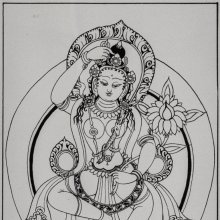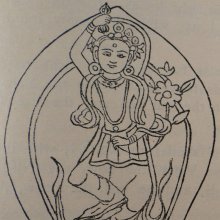Vajranatha, Vajranātha, Vajra-natha: 3 definitions
Introduction:
Vajranatha means something in Buddhism, Pali, Hinduism, Sanskrit. If you want to know the exact meaning, history, etymology or English translation of this term then check out the descriptions on this page. Add your comment or reference to a book if you want to contribute to this summary article.
Images (photo gallery)
In Buddhism
Tibetan Buddhism (Vajrayana or tantric Buddhism)
Source: archive.org: The Indian Buddhist IconographyVajranātha (वज्रनाथ) or Vajranāthalokeśvara refers to number 107 of the 108 forms of Avalokiteśvara found in the Machhandar Vahal (Kathmanu, Nepal). [Machhandar or Machandar is another name for for Matsyendra.].
Accordingly,—
“Vajranātha is identical with Vajrapāṇi Lokeśvara, with the only difference that here the god holds the lotus in his left hand.—Vajrapāṇi Lokeśvara again is identical with [Piṇḍapātra Lokeśvara], in all respects except that here the god holds the Vajra on his head with his right hand, while the empty left is held near the navel. The attitude in which he stands is also different. He shows the dancing attitude in Ardhaparyaṅka.—Piṇḍapātra Lokeśvara is one-faced and two-armed and stands on a lotus. He holds the Piṇḍapātra (the bowl) in his two hands near the navel)”.
The names of the 108 deities [viz., Vajranātha] possbily originate from a Tantra included in the Kagyur which is named “the 108 names of Avalokiteshvara”, however it is not yet certain that this is the source for the Nepali descriptions.Source: MDPI Books: The Ocean of Heroes
Vajranātha (वज्रनाथ) refers to the “adamantine leader”, according to the 10th-century Ḍākārṇava-tantra: one of the last Tibetan Tantric scriptures belonging to the Buddhist Saṃvara tradition consisting of 51 chapters.—Accordingly: “Buddhas are inside the spaces of Vajras. [He should visualize] this all-pervasive [stream]. They emerge from the gnosis fire. [He] has a stream of nectar, the self-existing. [He should perform] consecration of the adamantine leader (vajranātha) by filling with the innate water (viz., the stream of nectar) Oṃ, for the glory of all Tathāgatas’ consecration, the pledge, hūṃ—[this is] the consecration mantra [...]”.

Tibetan Buddhism includes schools such as Nyingma, Kadampa, Kagyu and Gelug. Their primary canon of literature is divided in two broad categories: The Kangyur, which consists of Buddha’s words, and the Tengyur, which includes commentaries from various sources. Esotericism and tantra techniques (vajrayāna) are collected indepently.
Languages of India and abroad
Sanskrit dictionary
Source: Cologne Digital Sanskrit Dictionaries: Aufrecht Catalogus CatalogorumVajranātha (वज्रनाथ) as mentioned in Aufrecht’s Catalogus Catalogorum:—Brahmavāda.
Sanskrit, also spelled संस्कृतम् (saṃskṛtam), is an ancient language of India commonly seen as the grandmother of the Indo-European language family (even English!). Closely allied with Prakrit and Pali, Sanskrit is more exhaustive in both grammar and terms and has the most extensive collection of literature in the world, greatly surpassing its sister-languages Greek and Latin.
See also (Relevant definitions)
Partial matches: Vajra, Natha.
Starts with: Vajranathalokeshvara.
Ends with: Mahavajranatha.
Full-text: Brahmavada, Vajranathalokeshvara.
Relevant text
Search found 1 books and stories containing Vajranatha, Vajranātha, Vajra-natha, Vajra-nātha; (plurals include: Vajranathas, Vajranāthas, nathas, nāthas). You can also click to the full overview containing English textual excerpts. Below are direct links for the most relevant articles:
The Indian Buddhist Iconography (by Benoytosh Bhattachacharyya)

